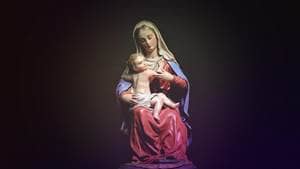
Mary holds a place of honor in the Roman Catholic, Eastern Orthodox, Oriental Orthodox, and High-Church Anglican traditions. Indeed, even in Islam, Mary receives significant reverence for the role she has played in the history of God’s workings with humankind. While the various Low-Church Protestant denominations don’t revere or venerate her, they do traditionally acknowledge the virgin birth and Mary’s goodness—in that she was clearly used by God as an instrument in bringing to pass His work and humanity’s salvation. All that said, Roman Catholicism has a higher and more developed view of Mary and her role than any other religious tradition.
Among other things, Catholic Mariology teaches four important dogmas about the Virgin Mary. First, she is the “Mother of God” (sometimes referred to as the “Theotokos” or “god-bearer”). Second, she was born without the taint of “original sin” (a dogma known as the “Immaculate Conception” of Mary). Third, she was a “perpetual virgin” (meaning she never consummated her marriage to St. Joseph, nor had sexual relations with any man). And fourth, that she was “Assumed into heaven” (meaning that, at the end of her life, Mary was immediately taken—body and soul—into heaven, and dwells there with the resurrected Jesus).
While the dogma of the “Assumption of the Blessed Virgin” is an “official” teaching of the Roman Catholic Church and is widely accepted by the vast majority of practicing Catholics today, there is no scriptural or patristic support for this teaching. In other words, nothing in the Bible or the early Church refers to this idea openly or with any measure of clarity. However, some Catholic biblical scholars have interpreted the “woman clothed with the sun…in heaven” (Revelation 12:1) as a veiled reference to the doctrine of Mary’s “Assumption.” However, that specific passage is read quite differently by other Christian denominations, and certainly doesn’t teach this doctrine with any measure of transparency. As a consequence, the Roman Church’s support for this dogma does not come primarily from scripture or the Apostolic Fathers but, instead, from post-Nicene leaders of the Church.
It was rather early in Christianity’s history that this teaching began to surface. Indeed, one source states, “Beginning in the fourth century western theologians began to write of the Assumption of Mary into heaven, body and soul. In the Eastern Church this was celebrated as the Dormition, or Falling Asleep of the Blessed Virgin.” Thus, regardless of the lack of scriptural proof for this belief, within centuries after the death of Jesus, speculation about this idea arose and, by the mid-seventh century, Mary’s “bodily assumption into heaven” had become part of her feast day. Prominent Medieval theologians, such as St. Gregory of Tours (in the West) and Theoteknos, bishop of Livias (in the East). were openly advocating this dogma—even though it would not become an “infallible teaching” of the Church for more than twelve centuries after these men pushed for its acceptance. From the thirteenth century onward, the dogma of the “Assumption” was largely taken as a “given,” with significant theologians (e.g., Aquinas, Bonaventure, etc.) supporting it, and lay members embracing it.
Pope Pius XII was the one who enshrined this dogma as “official” Catholic doctrine. In his November 1, 1950, apostolic constitution (or papal bull), Munificentissimus Deus, Pius explained that Mary, who was already held to have been a perpetual virgin, was (upon her death) immediately “received up into heaven.” While there was some vagueness in the implications of what Pius XII taught, generally speaking, this teaching was well received by Roman Catholics. (Only 2% of bishops at the time dissented, expressing some questions about the accuracy of this dogma.) Thus, though being taught in some form or another for well over a millennium, most (in the mid-twentieth century) fully embraced as “infallible” doctrine of the Church that the “Blessed Virgin Mary” was (upon death) “assumed up into heaven.”
Questions lingered after this longstanding belief was declared “official.” For example, Pope Pius XII did not specifically state whether Mary actually died prior to her assumption, or if she was simply “assumed up into heaven” without experiencing death. To this day, though the official position is that she did die, some lay Catholics think she did not. Also left to question was the possibility that she died but did not “taste of death” (or suffer in dying) when her soul was assumed up into heaven. Again, the most common belief is that she did experience death in ways that any other person would, but not all agree—and Pius’ 1950 papal bull did not directly answer the question as to whether Mary “felt” her death or was spared that experience. None of these questions are important, but each has been asked about the Virgin’s “Assumption.”
One thing that is not in question is whether Mary’s “Assumption” prevented her mortal body from experiencing any “corruption” in the grave (or tomb). Pius directly addressed this, writing:
“According to the general rule, God does not will to grant to the just the full effect of the victory over death until the end of time has come. And so it is that the bodies of even the just are corrupted after death, and only on the last day will they be joined, each to its own glorious soul. Now God has willed that the Blessed Virgin Mary should be exempted from this general rule. She, by an entirely unique privilege, completely overcame sin by her Immaculate Conception, and as a result she was not subject to the law of remaining in the corruption of the grave, and she did not have to wait until the end of time for the redemption of her body.” (Vv:4-5)
Thus, as with so many other aspects of her life, Mary is seen as an exemplar and even as an “exception to the rule.” Because of her ascension into the presence of God, the Blessed Virgin—according to Pius—now and forever “lives in union with the risen Christ”; a blessing we all hope for, and one which Mary experienced immediately upon her passing.
In explaining the “Whys” of the “Assumption of the Blessed Virgin,” some reason that, since Mary gave Jesus “life” (as His mother), He then would “return the favor,” giving “life to her body” when He drew her to heaven. By the Middle Ages, Catholic theologians regularly spoke of the logic of Jesus obeying the commandment to “Honor thy…Mother” (Exodus 20:12) through preventing the flesh of his mother, the very woman who gave Him life, from being “consumed by worms.” Others point out that, since the Virgin “completely overcame sin by her Immaculate Conception,” how could it be otherwise (that she was “assumed” into heaven). Her lack of original sin and her perfectly lived life almost guaranteed her assumption.
One of the important theological consequences of this doctrine became the Catholic Church’s unique emphasis on the Virgin’s “salvific mission” as the “mother of God.” The dogma of the “Assumption of the Blessed Virgin” is the source for the common Roman Catholic belief that the Virgin Mary has an “intercessory role” in the lives of faithful Catholics. Consequently, in the 18th century, St. Alphonsus Liguori (1696-1787) referred to the Blessed Virgin as “Mediatrix” (meaning “to be in the middle” or to be an “intercessor”). Similarly, Saint John Paul II toyed with “officially” declaring her “Co-Redemptrix with Christ,” though was purportedly discouraged from doing so by Joseph Cardinal Ratzinger (who would succeed John Paul, becoming Pope Bennedict XVI). Nonetheless, Pope John Paul II frequently spoke publicly of how “coredemption assumes a unique form in Mary.” The dogma of the “Assumption” emphatically elevated Mary to a role in which she had “intercessory” power in a way that no other saint or human would have.
Another consequence of the dogma of the “Assumption” was to suggest that the Blessed Virgin is an “example” to us all. This teaching was officially declared a “dogma of the Church” shortly after the conclusion of WWII—in a time of warfare and growing materialism (indicative of the 1930s-40s). This doctrine embodied the truth that we should each seek to “care for others” and grow in our personal “virtue” and “holiness” so that we, like the Blessed Virgin, could be worthy of experiencing the “Beatific Vision.” As the Encyclopedia of Catholicism states: “The Assumption…has a universal significance. The religious meaning of this dogma centers on the eschatological victory of God's grace, freely given in Christ, which consecrates and ultimately saves the whole person, both body and soul.” And, as Pope Paul VI wrote (in his November 21, 1964 text, Lumen Gentium), Mary, “the Mother of Jesus, glorified in body and soul in heaven, …does…shine forth on earth, until the day of the Lord shall come, as a sign of sure hope and solace to the people of God during its sojourn on earth.” (V:68) So, the dogma of the “Assumption” is a doctrine of optimism. Mary’s assumption gives hope and promise to all who, like her, seek to live a life of holiness and devotion, offering each the ability to follow in her path and return to their God pure and worthy of His divine presence.
An additional consequence of this declared dogma is perceivably negative, at least for those outside of the Catholic tradition. As a papal decree, this teaching has served to drive a soteriological wedge between low-Church protestants and Roman Catholics; largely because this dogma came with “anathemas resulting in excommunication for non-belief.” In other words, when this dogma was first promulgated, it was done in such a way as to suggest (to those outside of the Catholic Church) that, should they reject it, the impact on their salvation would be dire. Of course, Protestants of all stripes rejected that claim, and the Roman Catholic Church since Vatican II (1962-1965) has largely drawn back from many of their former claims to there being “no salvation outside of the Church.” Nonetheless, when the doctrine was first declared, those outside of the Church of Rome found themselves feeling the condemnation inherent in the dogma promulgated by Pope Pius XII.
Of all the influential dogmas of the Roman Catholic Church, its Mariology is one of the most unique and certainly one which sets Catholics apart from other Christians—both in beliefs and practices. And, if we can say nothing else about the “Assumption of the Blessed Virgin” into heaven, we can with certitude say this: this doctrine has elevated Mary in the eyes of faithful Catholics in ways that almost no other teaching of the Church could.
8/2/2024 8:56:57 PM










